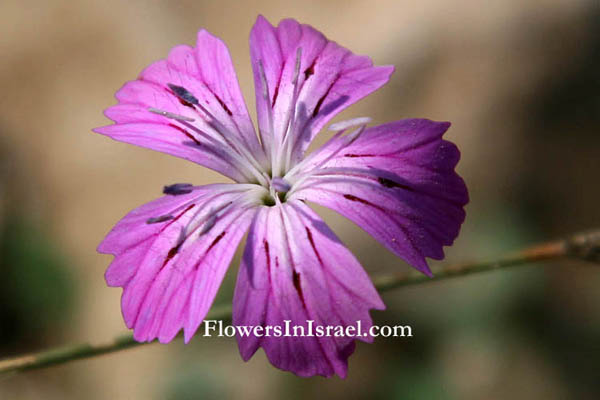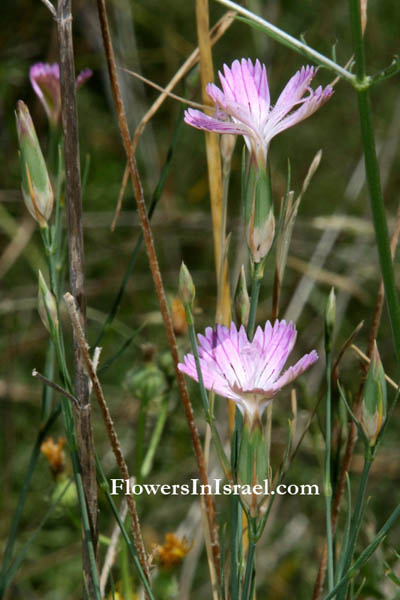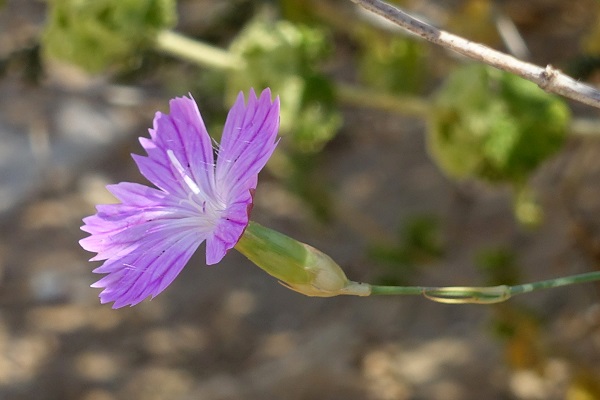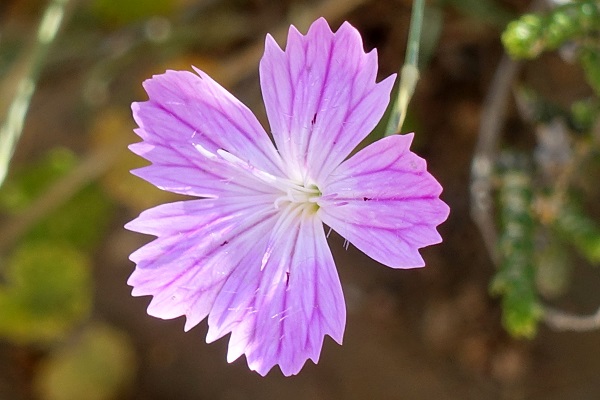Wild carnation, Wild Pink, Hebrew: צפורן נקוד, Arabic: القرنفل المنتصب
| Scientific name: | Dianthus strictus Banks et Solander | |
| Synonym name: | Dianthus polycladus Boiss., Dianthus multipunctatus Ser. | |
| Common name | Wild carnation, Wild Pink | |
| Hebrew name: | צפורן נקוד | |
| Arabic name: | القرنفل المنتصب | |
| Plant Family: | Caryophyllaceae, ציפורניים |

|
| Life form: | Hemicryptophyte | |
| Stems: | Up to 20 cm; | |
| Leaves: | Opposite, entire | |
| Inflorescence: | Solitary | |
| Flowers: | Pink, white; epicalyx (=a group of bracts simulating a calyx) 1/3 as long as calyx,pointed; calyx conical, verruculose, purple lines on the teeth continued from sinuses; petal-limb dentate, bearded | |
| Fruits / pods: | Capsule, many seeded | |
| Flowering Period: | April, May, June, July, August, September, October | |
| Habitat: | Batha, Phrygana, Shrub-steppes | |
| Distribution: | Mediterranean Woodlands and Shrublands, Semi-steppe shrublands, Shrub-steppes, Deserts and extreme deserts, Montane vegetation of Mt. Hermon | |
| Chorotype: | Mediterranean | |
| Summer shedding: | Perennating |

Derivation of the botanical name: Dianthus, probably alteration of Greek diosanthos, carnation: dios, "god", anthos, "flower", and was cited by the Greek botanist Theophrastus. strictus,drawn close together, very upright, very straight. carnation, from "coronation" or "corone" (flower garlands), as it was one of the flowers used in Greek ceremonial crowns. Carnations are thus "The Flowers of God". Carnations were known as "Jove's Flower" in ancient Rome as a tribute to Jupiter, a supreme Roman deity. The Hebrew name:ציפורן, tsiporen, Aramaic: טופרא, Topra, nail, from the German name "Nelke" (from the Middle High German negelkin "Nägelchen"), based on the comparison of its aromatic, nail-shaped flowers with the shape-like buds of the cloves.
Carnation or pink, especially when red, is a symbol of betrothal. According to a Flemish custom, a variety of carnation, the pink, was worn by the bride upon the day of her wedding, and the groom was supposed to search her and find it. From this custom, the pink has become a symbol of marriage. In portrait painting, especially of the 15th and 17th cents, when held in the sitter's hand it signifies that the picture commemorates his betrothal. The carnation often appears in paintings of the Virgin Mary and Jesus, in which Mary holds a carnation out to Jesus, as in the painting by Raphael, "Madonna of the Pinks," or the painting "Madonna of the Carnation" by Albrecht Durer (1516). The pink carnation became the symbol of a mother's undying love, and in 1907 was chosen by Ann Jarvis as the emblem of Mother's Day, now observed in the United States and Canada on the second Sunday in May. A red carnation may be worn if one's mother is alive, and a white one if she has died. 

Location: Timna Valley, southwestern Arava/Arabah. 
Location: Timna Valley, southwestern Arava/Arabah. |